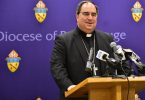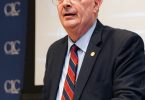
by Julie Asher
A hundred years ago, the U.S. Catholic bishops were insightful enough to realize there was a role for a news service to provide accurate information about the church, said Thomas Lorsung, retired director and editor-in-chief of Catholic News Service.
“And they were smart enough to see this should be put into the hands of professional journalists,” he said in an interview. “It wasn’t a question of just having knowledge of theology,” but knowing how to report on the workings of the church “and get at information people could use.”
“In this crazy world, I think it’s terrifically important for the news service to do what it does — it presents unbiased professional journalism,” Lorsung added. “That’s what people need. They don’t need to get tied up in the sharp divisions we have now in the world. . . . Maybe I have seen far too much shabby and slanted coverage from newspapers.”
From the start, he said, it was clear the bishops wanted an authentic news agency that would report “fully, fairly and freely” on the church itself as well as its involvement in the world.
Founded in 1920 as the NCWC News Service, it was part of the bishops’ National Catholic Welfare Council.
The hierarchy first established the council as the National Catholic War Council in 1917 to better address challenges posed by World War I. Its successor was the National Catholic Welfare Council in 1919; in 1922, it became the National Catholic Welfare Conference — the precursor to the National Catholic Bishops Conference and U.S. Catholic Conference. These twin conferences were combined and officially renamed the U.S. Conference of Catholic Bishops in early 2001.
The news service changed its name in the 1960s to National Catholic News Service, or NC News. In 1986 “National” was dropped, because Catholic News Service better reflected its mission of covering the world.
The service’s founding director was Justin McGrath, a veteran journalist and managing editor of the San Francisco Examiner. He also had worked at The New York Times and other dailies and was Washington bureau chief of the Hearst papers. McGrath helmed the news service from 1920 until 1932.
Succeeding McGrath was Frank Hall, who had been city editor at The Washington Post; he served from1932 to 1963. Then came Floyd Anderson, Richard Guilderson, A.E.P. “Ed” Wall, Richard W. Daw, Lorsung, Tony Spence and Greg Erlandson, CNS’ current director and editor-in-chief.
Lorsung’s tenure as director and editor-in-chief is the second longest in the agency’s history. He was named to the post in 1989 and retired at the end of 2003. He first joined the news service in 1972 as photo editor, then he was news editor, then managing editor before being named to head CNS.
In his time, CNS made its own technological strides in how it delivered the news and photos, going from wire transmissions in the 1980s to satellite delivery to internet delivery. In the past decade, CNS has expanded visual storytelling to include news videos distributed on YouTube.
“CNS is keeping up with developments in journalism and technology, like video and digital platforms,” Lorsung noted.
He thinks the new technologies are great but also said the most valuable way for bishops to communicate to their flock is with print — “something to put in homes that is quite tangible.”
“That’s not to say you can’t look for other ways to communicate. Print isn’t the only way. . . . You have to use as many resources as you possibly can and see how that all fits into a plan” for communications. “That’s the challenge for everyone,” he added.
Lorsung also said it was distressing to see on Facebook and elsewhere on the Web the news that some Catholic newspapers have gone out of business due to the economic blow the COVID-19 pandemic has delivered to dioceses, among other pressures.
Looking ahead to the next 100 years for CNS, Lorsung said: “The strength of the CNS Rome bureau is always going to be the biggest asset of the news service. You can look at the kind of steady and important careful coverage done by the bureau with Cindy Wooden as bureau chief. And I’m impressed by still photos CNS is able to provide its clients by Paul Haring.”
“It’s reassuring to see that 100 years ago the bishops of this country were insightful enough to realize they needed something like CNS and by extension the rest of Catholic press. Let’s hope that kind of thinking can be restored to the hierarchy today. I think it can,” Lorsung said.
“I think helping people understand the Catholic perspective is one of the most important roles for CNS,” said Spence, director and editor-in-chief from 2004 to 2016, who, like Lorsung, is a past winner of the Catholic Press Association’s 2010 St. Francis de Sales Award.
“CNS is one of the largest and certainly the oldest religious newsgathering organization in the world and because of that it is held in very high esteem around the world by other journalists, Catholic leaders and thought leaders,” he said in an interview. “So with that foundation, it is a great influencer of Catholic thought and perspective for readers and leadership around the world.”
Most media “just do not report news from the religious perspective, and often the religious perspective is not included in straight reporting,” he continued. “You see, for example, a report on some global problem (and) reporters will speak to political leaders, academic leaders or nonprofit leaders, but they don’t often talk to religious leaders.”
Today, there are almost no religion writers in the secular press, Spence said, noting that in North America at least, back in the day nearly every media outlet had somebody specifically appointed to cover religion and “that is certainly no longer,” yet “religion stories abound.”
The media business is constantly changing but what will not change are the standards of CNS’ reporting and its commitment to accuracy and fairness, he added.
“Part of CNS’ cachet is it has built and continues to hold relationships with other Catholic newsgathering outlets around the world and media advocacy groups,” added Spence.
He pointed to CNS’ good working relationships with the Germany-based KNA, UCA News and other outlets. He also noted CNS staff members are involved in professional journalism organizations, among them the CPA, recently renamed the Catholic Media Association; SIGNIS, the World Catholic Association for Communication; and the Society for Professional Journalists.
Adding to the professionalism of CNS, Spence said, is the fact that for about 50 years, its nonmanagement employees have belonged to the Washington-Baltimore Newspaper Guild, now called The NewsGuild-CWA.
Some CNS reporters also have served — and continue to serve — on the guild’s executive committee. And the news service helps train up-and-coming journalists through strong internship programs at its Rome bureau and its Washington headquarters.
CNS “has staying power,” Spence said, because of its “sheer tenacity,” its efforts to always be considering new media outlets to carry its photos and stories, and above all the “quality of its reporting.”
“I don’t think any other Catholic news organization can touch” the quality, he added. “It really sets the standard globally.”






